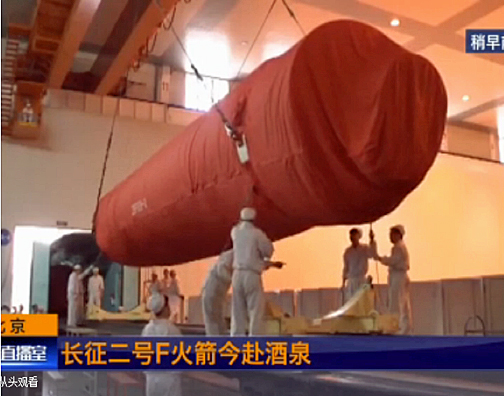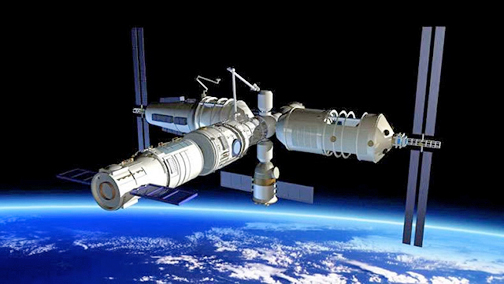
Being loaded on a train for transportation to the Jiuquan launch site is a Long March 2F rocket. Image courtesy of CCTV.
For the first time in China, two Chang Zheng 2F rockets are being transported simultaneously to the Jiuquan Satellite Launch Center by rail—these rockets will be launching China's first human spaceflight missions since their original foray in 2013—this launch is scheduled for September, according to infosite GB Times and author Andrew Jones.
Tiangong-2, the country’s second space lab, will launch in mid-September and will be visited soon after by a crewed Shenzhou spacecraft carrying two astronauts. According to the report, the Tiangong-2 launch vehicle offers a wider payload fairing that will facilitate the new space lab, while the Shenzhou mission's rocket possesses an emergency escape system that will separate the rocket from the spacecraft in case an emergency occurs. So far, China has launched ten Long March 2F rockets without a single failure, the first being the Shenzhou-1 mission in 1999.

Artistic rendition of China's Tiangong-2 spacelab.
The Tiangong-2 and Shenzhou-11 will rendezvous and dock in orbit 393 kilometers above the Earth. This is the altitude that is planned for China’s yet-to-be-completed modular space station, which has a 2020 mission launch date. The Tiangong-2 space lab will also test life support systems and, next year, will also be used to test the crucial on orbit propellant resupply system and has a number of upgrade modifications that should make the astronauts aboard her to be more comfortable.
Tiangong-2 is expected to carry 51 payloads and 14 experiments, according to sources at the Chinese Academy of Science. The spacelab research will be conducted into fluid physics in astronomy, Earth science, fluid physics, microgravity, space biology and the space environment in general. An additional project for Tiangong-2 will engage the onboard astronauts to initiate a number of technical and other relevant experiments that will be designed to examine various aspects of operation for China's future space station.
China's Tianzhou-1 cargo vessel—the nation's first resupply spacecraft—will also carry experiments and is scheduled to be lofted from the Wenchang Launch Center during the first half of 2017. Should all proceed without mishap for Tiangong-2, Shenzhou-11 and Tianzhou-1 as well as the launch of the new heavy-lift Long March 5 rocket that will be used to propel the space station modules later this year, the core module of the space station should then see a 2018 launch date.

